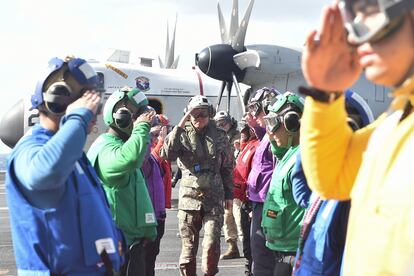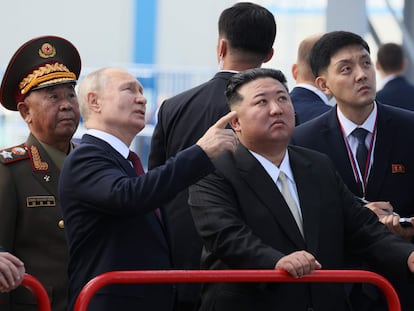The US, South Korea and Japan conduct naval drills in a show of strength against North Korea
Kim Jong Un has been on a provocative run of weapons testing and threats that raised regional tensions to their highest point in years

The United States, South Korea and Japan conducted perhaps their biggest-ever combined naval exercises in a show of strength against nuclear-armed North Korea, South Korea’s military said Wednesday. The three allies’ senior diplomats were to meet in Seoul to discuss the worsening standoff with Pyongyang.
The training in waters off South Korea’s Jeju island, which involved an American aircraft carrier, was aimed at sharpening the countries’ combined deterrence and response capabilities against North Korean nuclear, missile and underwater threats, and also training for preventing illicit maritime transports of weapons of mass destruction, South Korea’s Joint Chiefs of Staff said. It didn’t specify whether the training reflected concerns about North Korea’s alleged arms transfers to Russia to help that country’s war in Ukraine.
North Korean leader Kim Jong Un has been on a provocative run of weapons testing and threats that raised regional tensions to their highest point in years.
On Monday at Pyongyang’s rubber-stamp parliament, Kim declared that North Korea would abandon its long-standing commitment to a peaceful unification with South Korea and ordered a rewriting of North’s constitution to eliminate the idea of a shared statehood between the war-divided countries. He said South Koreans were “top-class stooges” of America who were obsessed with confrontation, and repeated a threat that the North would annihilate the South with its nukes if provoked.
Kim’s speech came a day after the North conducted its first ballistic test of 2024, which state media described as a new solid-fuel, intermediate-range missile tipped with a hypersonic warhead, reflecting its push to advance its lineup of weapons targeting U.S. military bases in Guam and Japan.
In response to the North’s heightened testing activity, the United States and its Asian allies have been expanding their combined military exercises. Kim condemns the demonstrations as invasion rehearsals, and the drills increasingly feature major U.S. military assets, including aircraft carriers, long-range bombers and nuclear-capable submarines.
Kim has also been strengthening his regional footing by boosting the visibility of his ties with Russia and China — two neighbors that are also locked in confrontations with the United States — as he attempts to break out of isolation and join a united front against Washington.
North Korean Foreign Minister Choe Son Hui traveled to Moscow, where she met Tuesday with Russian President Vladimir Putin for talks on improving bilateral relations amid growing international concern about alleged arms cooperation between the countries.
The North’s official Korean Central News Agency said Choe in a separate meeting with Russian Foreign Minister Sergey Lavrov had unspecified discussions on intensifying their countries’ “joint action over the regional and international issues including the situation in the Korean Peninsula.”
South Korea’s Joint Chiefs of Staff said the trilateral naval drills — a three-day program that concluded Wednesday — involved nine warships, including U.S. aircraft carrier Carl Vinson and Aegis destroyers from South Korea and Japan. The drills usually involve around five vessels. South Korea’s military did not immediately confirm media assessments that the exercise was the country’s largest trilateral naval drill.
In Seoul, South Korean nuclear envoy Kim Gunn met Wednesday with Japanese counterpart Hiroyuki Namazu ahead of a trilateral meeting planned for Thursday with U.S. President Joe Biden’s deputy special representative for North Korea, Jung Pak, to coordinate their response to the North. Kim and Namazu discussed the North Korean leader’s latest comments toward the South and the North’s recent military actions, including Sunday’s missile test and its recent artillery firings near a disputed sea boundary with the South, Seoul’s Foreign Ministry said.
“The two sides regretted North Korea’s aggressive rhetoric that misrepresents the cause of rising regional tensions and threatens war, and agreed that such actions will only strengthen trilateral security cooperation” with Washington, the South Korean ministry said in a statement.
The envoys also discussed Choe’s visit to Russia and vowed to coordinate a “stern and unified” international response to any illicit military cooperation between Moscow and Pyongyang, the ministry said, including the alleged transfers of North Korean missiles to Russia.
The U.S. and South Korean governments have claimed that North Korea has been providing Russia with arms supplies, including artillery and missiles, to help prolong its invasion of Ukraine. Both Moscow and Pyongyang have denied the accusation.
While expanding his country’s military cooperation with Washington and Tokyo, conservative South Korean President Yoon Suk Yeol has also been seeking stronger reassurances from Washington that it would swiftly and decisively use its nuclear capabilities to defend its ally in the event of a North Korean nuclear attack.
Sign up for our weekly newsletter to get more English-language news coverage from EL PAÍS USA Edition
Tu suscripción se está usando en otro dispositivo
¿Quieres añadir otro usuario a tu suscripción?
Si continúas leyendo en este dispositivo, no se podrá leer en el otro.
FlechaTu suscripción se está usando en otro dispositivo y solo puedes acceder a EL PAÍS desde un dispositivo a la vez.
Si quieres compartir tu cuenta, cambia tu suscripción a la modalidad Premium, así podrás añadir otro usuario. Cada uno accederá con su propia cuenta de email, lo que os permitirá personalizar vuestra experiencia en EL PAÍS.
¿Tienes una suscripción de empresa? Accede aquí para contratar más cuentas.
En el caso de no saber quién está usando tu cuenta, te recomendamos cambiar tu contraseña aquí.
Si decides continuar compartiendo tu cuenta, este mensaje se mostrará en tu dispositivo y en el de la otra persona que está usando tu cuenta de forma indefinida, afectando a tu experiencia de lectura. Puedes consultar aquí los términos y condiciones de la suscripción digital.
More information
Archived In
Últimas noticias
Petro claims the ELN was the target of US attack in Venezuela
Maduro counterattacks Trump with rhetoric and announces downing of nine drug trafficking aircraft
‘Ecce Homo’: The miraculous disaster that made a small Spanish town famous
Return to sex testing at the Olympics: IOC edges closer to banning transgender women
Most viewed
- Sinaloa Cartel war is taking its toll on Los Chapitos
- Oona Chaplin: ‘I told James Cameron that I was living in a treehouse and starting a permaculture project with a friend’
- Reinhard Genzel, Nobel laureate in physics: ‘One-minute videos will never give you the truth’
- Why the price of coffee has skyrocketed: from Brazilian plantations to specialty coffee houses
- Silver prices are going crazy: This is what’s fueling the rally










































